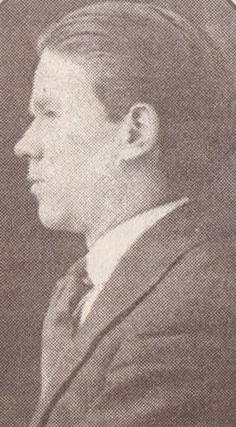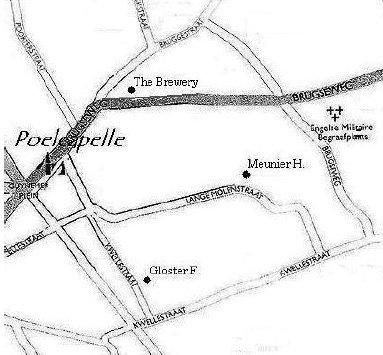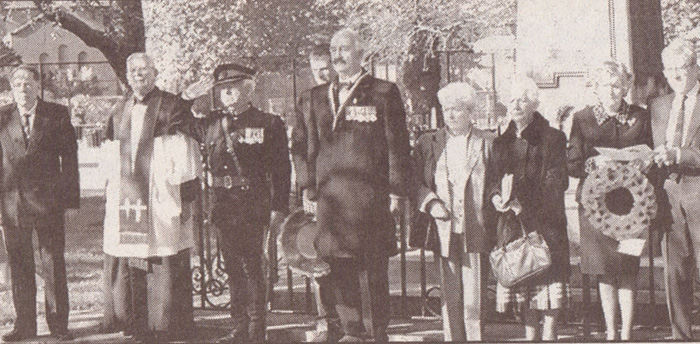

The missing soldier whose body was finally found in 1926 - and his name added to the Grangetown memorial 83 years after his death
William, usually called Bill by the family, was the second son in a family
of fiveboys and two girls and was born in Cardiff in 1894. His father, Benjamin,
originally from Dinas Cross, Pembrokeshire was a customs officer in Cardiff
docks. His mother Esther, née James, was born in Llangynllo, near Rhyddlewis,
Cardiganshire but had moved to Cardiff by the time she married Benjamin in 1891.
The family were living 9, Penhevad Street on both the 1901 and 1911 Censuses
but had moved to 118 Mardy Street by the time Bill enlisted in December 1915.
He enrolled as a private with the Welsh Horse. His Army records show that he
was 5ft 8 inches tall,with a chest girth, fully expanded of 35 inches and that
he weighed 136 lbs. Although he would seem slight by present day measurements,his
physical development was described as good.
My mother made some notes about him before she died and said she remembered
seeing photographs of him as a child and that he was handsome with thick, dark
hair and blue eyes. She said that he had volunteered for the Welsh Horse because
he had always wanted to ride. Indeed ,one of those photos she remembered showed
him in uniform on his horse. She added that when horses proved unsuited to modern
warfare, he was disgusted to be given a bicycle instead, although I think the
story became contracted in the telling.
What can be established from his records is that Bill was moved out of the
Welsh Horse after five months and posted to the 12th Lancers in Dublin on 19th
May 1916. This was a cavalry reserve regiment training recruits for active service.
Apparently although nominally cavalry, the demands of trench warfare saw many
converted into infantry.This certainly happened to Bill. On 29th November he
was transferred to the 7th Battalion of the East Kent Regiment,The Buffs and
was posted to France on 2nd December, nearly a year after he had originally
enlisted.
The Battalion had just come to the end of a very difficult period in the front
line at the Somme and their numbers had been severely weakened. Bill was one
of a draft of seven 2nd lieutenants and 315 men sent to join them where they
were recuperating at Marcheville. Considering that a First World War battalion
would have had a full compliment of around 1,000 men, this was sizeable number
of inexperienced men.
The battalion’s War Diary (National Archives Reference WO 95/2049/1)
shows that they spent the winter training in trench warfare with two days off
for Christmas and Boxing Day before joining the advance on the upper valley
of the Ancre on 23rd February 1917. They moved forward to occupy abandoned enemy
trenches in the fog, soon coming under heavy fire, which was probably Bill’s
first experience of these conditions.
As the Germans retreated to the Hindenberg Line, they advanced, travelling
over difficult terrain where roads were smashed and bridges destroyed. By March
they were training again at Boeseghem. Alongside physical training came musketry
and rifle drill, advanced guard schemes, bomb installation and bayonet fighting.
On 1st May they were sent to the front line south of Arras. The battalion’s
diary for 3rd May gives some idea of the fighting conditions: "The two
leading waves commenced to assemble in front of the final trench at 3.15 a.m.
The was done quietly and well in spite of the darkness, the moon having set….
At that time, owing to the darkness it was impossible to see the lines of men
until within two or three yards of them!”
Under intense bombardment and rifle fire, the attack failed. By night time,
the Buffs were back in the original front-line trenches. Two officers had been
killed, six wounded and four missing. 25 other ranks also died with 169 wounded
and 174 missing.
After these losses came a brief spell of re-organisation and training but the
7th Battalion were back in the trenches again by 21st May. The diary entry for
22nd May reads: "During the early morning, it rained very heavily and
the trenches became very bad. The men were at once put into digging sump pits.”
The enemy were later heard talking only 200 yards away. Trenches were repaired,
patrols of 2 or 3 men were sent out on a daily basis, often reporting back sightings
of the enemy. Until 15th June spells in the trenches alternated with turns in
reserve.
The Brigade was then moved back to take up headquarters at Couin. Colonel
R.S. Moody in his “Historical Records of the Buffs East Kent Regiment 1914-1919
comments that ”the only point of interest worth mentioning in the history of
the 7th up to the end of June is that it won the ten mile cross country relay
race for the 26th Division.” On 3rd July, the 55th Brigade, including the Buffs
were sent to join the 5th Army at Ouderdom west of Dickenbusch and joined the
front line south east of Ypres, entering into a routine of patrols and exchanges
of artillery fire. Time at the front alternated with brief periods at Chateau
Segars. This continued until mid August when they were moved to Eringhem, north
west of Steenvoorde for more training where they rehearsed such skills as the
negotiation of obstacles, fire control with movement, rapid wiring and formation
of company in attack. Moody states “Of course there was a great deal of training
at this time, but, even if the numerous drafts which required teaching and the
ever-changing conditions of warfare had not made this a necessity, still it
does not improve the health or the spirits of men so often exposed to the danger
of death to encourage or allow periods of utter indolence and the consequent
loafing and brooding.” The diary for 30th August states “The battalion sent
75 men to the seaside this morning.” By mid September, training intensified,
concentrating on attack formations but with time for church services and a weekly
football match.
On 23rd September, the Buffs were brought in by train to St Jean Tire Beizen.
Not long after they arrived, the camp was bombed by an enemy aircraft. The men
were sleeping in tents and huts in a congested area when four bombs exploded,
killing a 2nd Lieutenant and 26 men and wounding 67 others, Not only was this
disastrous on a personal level it also disrupted the arrangement of platoons
and manoeuvres rehearsed in training.
On 10th/11th October, the battalion were brought in to take over the front
line close to Poecapelle, occupying a line of posts from Gloster House to Poelcapelle
Church. Even from the start there were problems, a report attached to the War
Diary states “This operation was rendered difficult owing to the short notice
given and the impossibility of previous reconnaissance of the approaches.”
Some guides could not find their way and some disappeared altogether. Once
in position, movement to and from the front was difficult because the ground
was in full view of the enemy and there was frequent shelling. The terrain in
this area is very flat and aerial views from the time show nothing but mud,
pock-marked with shell craters. When new information came through from Brigade
Headquarters regarding enemy defences, the battalion report says.”This information
had to be given verbally to company commanders as their headquarters were in
shell holes and they consequently could not use lights to read written orders.”
Reconnaissance at 7a.m. showed the Germans to be holding Gloster House. The
report states that Captain Nicholson “who had for some time been doing his
best to reorganise and dig in where he was, although digging was practically
impossible owing to the swampy nature of the ground, states that at about 12
noon the hostile machine gun and rifle fire slackened somewhat.” He sent
a patrol to get in touch with elements of “A” Company. The 2nd Lieutenant in
charge of this patrol was mortally wounded. When Captain Nicholson went out
to help him he saw around 30 men being led away by the Germans. This left a
gap in the advance. They attempted to consolidate but could not because of the
state of the ground.
A party of Germans were seen advancing down the main street of Poelcapelle
but the advance was stopped by members of other British regiments who were in
the village.! ! From 5 p.m. to 6 p.m., enemy bombardment was fierce. Attacks
continues thoughout the night driven off by return fire. The day of 13th was
quieter “except for the usual sniping but the front line was shelled again between
2pm. and 4pm. Between 5pm and 5.30pm, the road as far as Delta House was very
heavily shelled, also Poelcapelle. By 9pm, all posts had been relieved by 7th
Queens and 7th Buffs withdrew to Meunier Farm. Casuallties were 10 officers
and 375 other ranks, missing, wounded or dead.
William Laugharne was amongst the missing but it was not until 29th July 1918
that the following entry was made on his records “Death Presumed on lapse of
time as having occurred on or since 13/10/1917.” He was posthumously awarded
the British War Medal Victory Medal and a memorial scroll and plaque was sent
to his family in 1920.
For some reason, even though he had been declared dead on his official records,
his name was not included on the Grangetown memorial and, according to family
stories, his parents entered into a lifelong campaign to have him honoured.
Their wish was not fulfilled until many years after their death when, in 2000,
the campaign was taken up by Bill’s niece, the late Ann Lewis, my mother’s cousin
and her husband, Tony. In an article in the South Wales Echo on 24th May, 2000
she said “I think it’s wonderful that Uncle Bill’s name will finally be where
it belongs. It should have been done a long time ago. When I went to see the
memorial and saw all the other names, I felt sad that he wasn’t there. People
might think we’re mad but I think its the right thing to do. Even after 80 years
the feelings are still there.”
The same article mentions that Bill’s body was found in 1926 by a Belgian
farmer while digging his field and that he was then buried with full military
honours at Poelcapelle British cemetery. This was something my mother also mentioned.
I do not know if any of the family attended this burial.
Ann Lewis also spoke of how, just after the war, her grandparents had still
held some hope that their son might return. She said that they often visited
a hospital set up at Ninian Park School for soldiers returning traumatised from
the war. “A lot of young men could not even remember who they were when they
returned after all they had been through.”
His name was finally added to the memorial at a special ceremony held on 13th
October 2000, 83 years after his death, with a bugler playing the Last Post.
The event was reported in the South Wales Echo, 14th October 2000. My
mother was born six years after her Uncle Bill was posted missing and his absence
made a strong impression on her as a child. One of her early memories was of
a photo of him in her grandparents home in Mardy Street, in uniform and mounted
on a horse. The frame had his war medals attached to it.
She wrote that he “left school fairly early and went into an office. He was
anxious to improve himself. Every week he bought a book from the Everyman Library
of books. When he died he left behind a collection of them. I used to go into
the bedroom at the back of the house in Mardy Street and read my way though
it during the holidays when my mother, father and I were staying there…. Mill
on the Floss by George Elliot, also Lady Chatterly’s Lover by D.H.Lawrence,
but a very watered down version!”
She would often talk to me about Bill when I was a child. That Everyman collection
had fired a deep love of literature which was to stay with her throughout her
life and I think that she felt that his premature death had taken away a potential
ally. She told me that there was once a brass plaque to his memory in Mount
Stuart Chapel on Cardiff Docks where the family worshipped and where Bill’s
father Benjamin was a Deacon.
© Vivien Boyes 2014
 William
Thomas Laugharne died at Ypres in 1917 but it was nine years before his body
was found by a Belgian farmer and given a military funeral. For some reason,
although missing presumed dead, his name was missed of the Grangetown war memorial.
But in a ceremony in the year 2000, he was added. VIVIEN BOYES tells the story
of her great uncle.
William
Thomas Laugharne died at Ypres in 1917 but it was nine years before his body
was found by a Belgian farmer and given a military funeral. For some reason,
although missing presumed dead, his name was missed of the Grangetown war memorial.
But in a ceremony in the year 2000, he was added. VIVIEN BOYES tells the story
of her great uncle.
 The barrage opened at 5.25 a.m. and two companies moved forward. Although
the battalion’s diary follows the movements of the different companies I have
not been able to establish which was Bill’s company. The barrage in some places
was late and erratic, some of it landing on top of “C” Company as they advanced.
They were also subjected to enemy machine gun fire from near Gloster House.
Soon “D” Company was also under machine gun fire from Meunier House and the
Brewery. The report states “Efforts to gain ground by fire and movement were
attempted but the heavy condition of the ground…. coupled with the machine gun
fire brought the attack to a standstill. “C” Company successfully rushed one
enemy post and captured a machine gun which was used with effect on the enemy.”
The barrage opened at 5.25 a.m. and two companies moved forward. Although
the battalion’s diary follows the movements of the different companies I have
not been able to establish which was Bill’s company. The barrage in some places
was late and erratic, some of it landing on top of “C” Company as they advanced.
They were also subjected to enemy machine gun fire from near Gloster House.
Soon “D” Company was also under machine gun fire from Meunier House and the
Brewery. The report states “Efforts to gain ground by fire and movement were
attempted but the heavy condition of the ground…. coupled with the machine gun
fire brought the attack to a standstill. “C” Company successfully rushed one
enemy post and captured a machine gun which was used with effect on the enemy.”

The ceremony in 2000 was attended by family and veterans' associations.